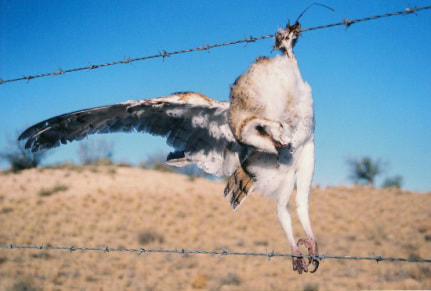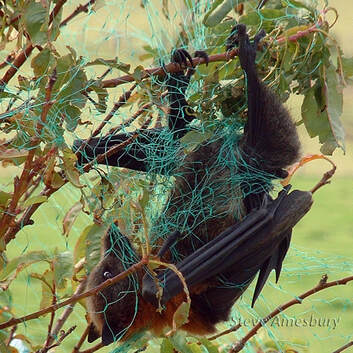|
ENTANGLEMENT - BARBED WIRE There are ways you can reduce the risk of wildlife becoming entangled on barbed wire fence, such as those listed below. Removal. If you dont run stock or have security needs you might use other fencing such native trees and shrubs which screen your property while providing habitat for local wildlife. Modification. Replacing the top strand of barbed wire with plain or coated wire, or covering it with poly pipe can reduce the risk of entanglement. High risk areas for entanglement are around ridge lines dams waterways near wildlife feed trees and fruit trees. Improve visibility. Many animals have difficulty seeing wire fences. Improve visibility by stringing electric fence tape above the top strand of barbed wire. Alternatively you can attach reflective materials such as metal tags along the top wire. |
Planting vegetation. You can assist the movement of aboreal mammals such as Koalas and possums, by planting native trees and shrubs along both sides of fence lines. This allows wildlife safe access as they traverse the fenceline. Don't plant wildlife-attracting trees or fruit trees alongside barbed wire, as and flying foxes may browse alongside the barbed wire and become entangled.
There is more info at the Wildlife Friendly Fencing website, or you can download the ‘Wildlife friendly fencing’ brochure (1.6 MB PDF) here
There is more info at the Wildlife Friendly Fencing website, or you can download the ‘Wildlife friendly fencing’ brochure (1.6 MB PDF) here
|
ENTANGLEMENT - TREE NETTING Netting of fruit trees is used to prevent wildlife from eating or damaging crops. Wildlife often become entangled and die in tree netting, including flying foxes, reptiles, birds and possums. The worst netting is monofilament bird netting. This fine nylon netting is readily available and cheap, but dangerous because it is virtually invisible to nocturnal wildlife. Nets are a threat to wildlife even after they lose their usefulness in protecting fruit, so please remove old netting from your property. Unsafe netting or poorly erected netting captures and kills thousands of flying foxes each year through strangulation and dehydration. Many of these are lactating females, with dependent young in the colony, who will slowly die from starvation. It is often the case that wildlife entangled in nets are not discovered for days, and for many, help will come too late. Thousands of entanglements create unnecessary suffering for wildlife and a burden on wildlife volunteers. Safe netting: There are less harmful alternatives available, including nets of white knitted materials, which is more visible to wildlife. A handy tip for recognising safe netting is to "the finger test" - If you are able to poke your finger through the netting it is unsafe. The best way to erect netting is to pull it tightly over a frame surrounding the tree or trees. Wildlife can ‘bounce’ off it or climb over it rather than getting entangled. Many brands of safe netting are now available in stores, such as Fruitsaver, Fruit-sock, Hailguard and Coolaroo. Visit the Wildlife Friendly Fencing website, or download the brochure (1.6 MB PDF) here |
This page last updated August 2019






